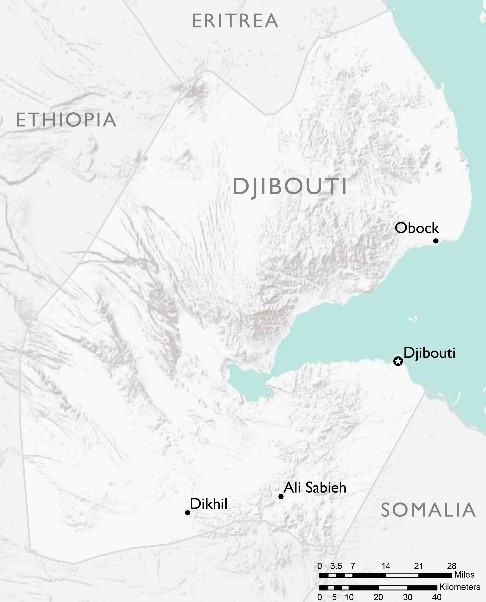Home » What We Do » Agriculture and Food Security » Food Assistance » Country Fact Sheets » Food Assistance Fact Sheet - Djibouti
- What We Do
- Agriculture and Food Security
- Democracy, Human Rights and Governance
- Economic Growth and Trade
- Education
- Ending Extreme Poverty
- Environment and Global Climate Change
- Gender Equality and Women's Empowerment
- Global Health
- Water and Sanitation
- Working in Crises and Conflict
- U.S. Global Development Lab

Map of Djibouti
September 28, 2017
Situation
- The March-to-May rainy season was average across Djibouti, supporting pasture regeneration, increased water availability, and improved livestock body conditions. However, pastoralists have lower-than-normal access to milk due to poor livestock productivity following the below-average October-to-February coastal rains. Many pastoralists are expected to remain in Stressed—IPC* 2—levels of food insecurity through September. Additionally, poor households in parts of Dikhil and Ali Sabieh regions have below-average herd sizes and are unable to sell sufficient livestock to meet their food and non-food needs. These households are expected to remain in Crisis—IPC 3—levels of acute food insecurity through the end of the lean season in September. The October-to-February rainy season is expected to be average or above-average, increasing availability of pasture and water resources through January.
- Djibouti hosts approximately 26,330 refugees from neighboring countries. The majority of this population are long-term refugees who have resided in camps in Ali Sabieh Region for up to 20 years. Refugee camps in Djibouti are located in very isolated areas and refugees are prohibited from working, leaving them dependent on assistance and vulnerable to food insecurity.
* The Integrated Food Security Phase Classification (IPC) is a standardized tool that aims to classify the severity and magnitude of food insecurity. The IPC scale, which is comparable across countries, ranges from Minimal—IPC I—to Famine—IPC 5.
Response
- The Office of Food for Peace (FFP) supports the UN World Food Program (WFP) to provide food assistance to 75,600 of the most vulnerable and severely food insecure in Djibouti, focusing on refugees and rural, food insecure households. FFP programs use U.S. in-kind food assistance in targeted relief and recovery interventions to reduce short-term hunger among rural communities that are affected by recurrent drought emergencies and increasing food prices, while also aiming to support asset creation activities that build community resilience to shocks. FFP provides U.S. in-kind food assistance to support general food distributions to refugees in Ali Addeh and Holl Holl camps in Ali Sabieh Region and Markazi camp in Obock Region.
- In Fiscal Year 2017, FFP also began providing support for cash transfers to complement the in-kind food distributions. This cash transfer aims to help improve the nutrition status of refugees by increasing their dietary diversity, as well as increasing their purchasing power and supporting local markets. FFP also provides funding and in-kind Ready-to-Use Therapeutic Foods (RUTF) to UNICEF to treat severe acutely malnourished children under five throughout Djibouti.
Food for Peace Contributions
Total Contributions:
| U.S. Dollars | Metric Tons | |
|---|---|---|
| Fiscal Year 2017 | $5.1 million | 3,458 MT |
| Fiscal Year 2016 | $3.8 million | 3,880 MT |
| Fiscal Year 2015 | $2.8 million | 2,800 MT |







Comment
Make a general inquiry or suggest an improvement.